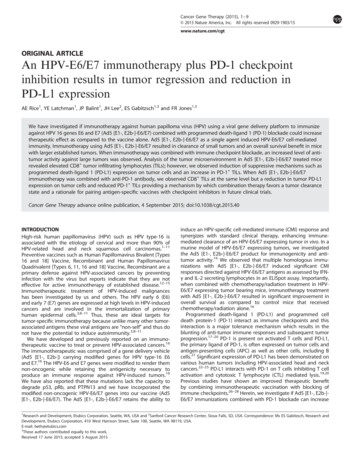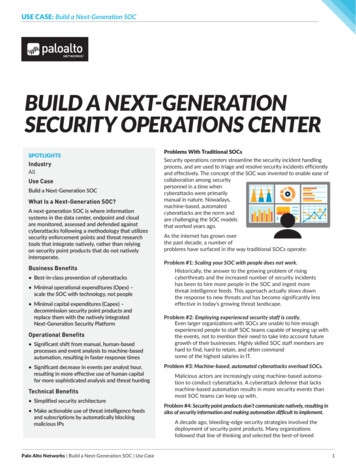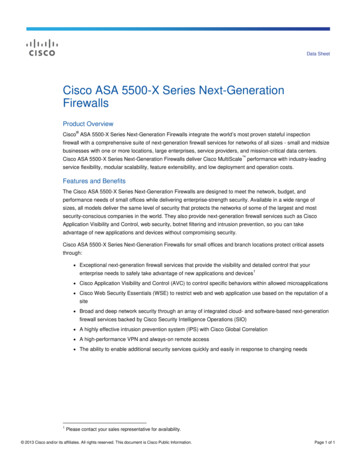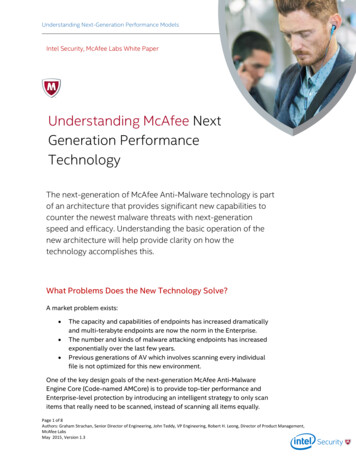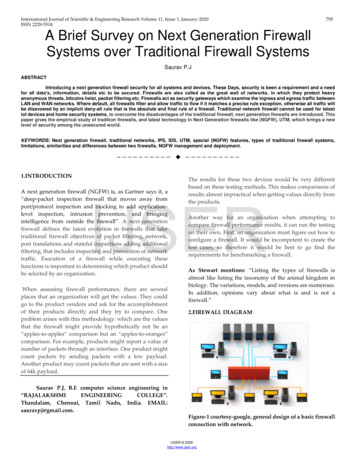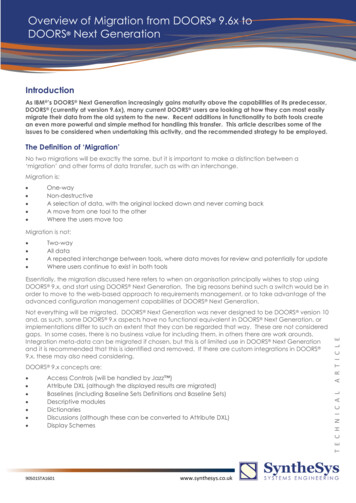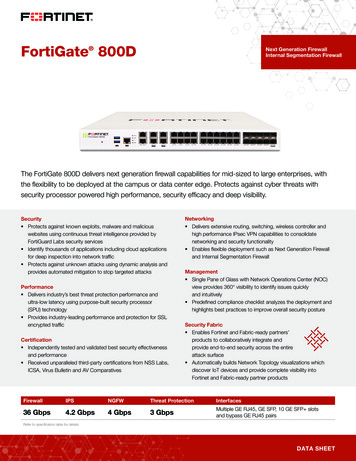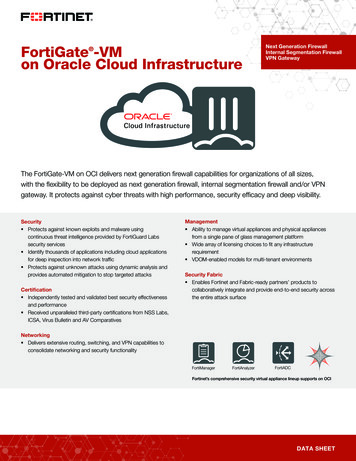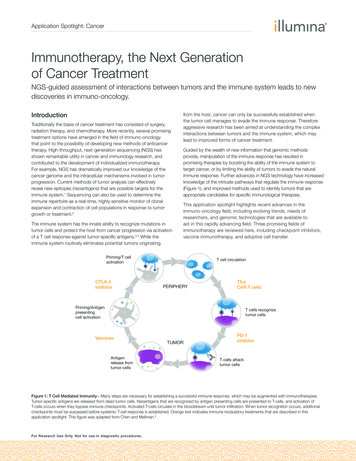
Transcription
Application Spotlight: CancerImmunotherapy, the Next Generationof Cancer TreatmentNGS-guided assessment of interactions between tumors and the immune system leads to newdiscoveries in immuno-oncology.IntroductionTraditionally the basis of cancer treatment has consisted of surgery,radiation therapy, and chemotherapy. More recently, several promisingtreatment options have emerged in the field of immuno-oncologythat point to the possibility of developing new methods of anticancertherapy. High-throughput, next-generation sequencing (NGS) hasshown remarkable utility in cancer and immunology research, andcontributed to the development of individualized immunotherapy.For example, NGS has dramatically improved our knowledge of thecancer genome and the intracellular mechanisms involved in tumorprogression. Current methods of tumor analysis can effectivelyreveal new epitopes (neoantigens) that are possible targets for theimmune system.1 Sequencing can also be used to determine theimmune repertoire as a real-time, highly sensitive monitor of clonalexpansion and contraction of cell populations in response to tumorgrowth or treatment.2The immune system has the innate ability to recognize mutations intumor cells and protect the host from cancer progression via activationof a T cell response against tumor-specific antigens.3,4 While theimmune system routinely eliminates potential tumors originatingfrom the host, cancer can only be successfully established whenthe tumor cell manages to evade the immune response. Thereforeaggressive research has been aimed at understanding the complexinteractions between tumors and the immune system, which maylead to improved forms of cancer treatment.Guided by the wealth of new information that genomic methodsprovide, manipulation of the immune response has resulted inpromising therapies by boosting the ability of the immune system totarget cancer, or by limiting the ability of tumors to evade the naturalimmune response. Further advances in NGS technology have increasedknowledge of the intricate pathways that regulate the immune response(Figure 1), and improved methods used to identify tumors that areappropriate candidates for specific immunological therapies.This application spotlight highlights recent advances in theimmuno-oncology field, including evolving trends, needs ofresearchers, and genomic technologies that are available toaid in this rapidly advancing field. Three promising fields ofimmunotherapy are reviewed here, including checkpoint inhibitors,vaccine immunotherapy, and adoptive cell transfer.Priming/T cellactivationCTLA-4inhibitorT cell circulationPERIPHERYTILsCAR T cellsPriming/Antigenpresentingcell activationT cells recognizetumor cellsVaccinesAntigenrelease fromtumor cellsTUMORPD-1inhibitorT cells attacktumor cellsFigure 1: T Cell Mediated Immunity—Many steps are necessary for establishing a successful immune response, which may be augmented with immunotherapies.Tumor-specific antigens are released from dead tumor cells. Neoantigens that are recognized by antigen presenting cells are presented to T-cells, and activation ofT-cells occurs when they bypass immune checkpoints. Activated T-cells circulate in the bloodstream until tumor infiltration. When tumor recognition occurs, additionalcheckpoints must be surpassed before systemic T-cell response is established. Orange text indicates immune modulatory treatments that are described in thisapplication spotlight. This figure was adapted from Chen and Mellman.3For Research Use Only. Not for use in diagnostic procedures.
Application Spotlight: CancerCheckpoint InhibitorsExome SequencingThe immune system has an elaborate network of mechanisms torecognize foreign pathogens or mutated epitopes that tumor cellspresent. Efforts made over the past decades have informed the currentunderstanding about immune cell-intrinsic checkpoints that can prevent Tcell activation. These are commonly used by tumors to evade the immuneresponse. Manipulation of these checkpoints has shown great promisein recent therapeutic approaches.5 One key checkpoint occurs duringT cell priming by antigen presenting cells, which requires costimulatorybinding of the B7 ligand. Binding of B7 by the CTLA-4 receptor resultsin suppression of the T cell response (Figure 2A). In 2011, the FDAapproved a monoclonal antibody against this receptor (ipilimumab)for clinical use in metastatic melanoma. Another key checkpoint is thebinding of PD1 to PDL1, for which 2 anti-PD1 antibodies (pembrolizumaband nivolumab) were approved in 2014 (Figure 2B), and more inhibitorydrugs are under development. Both of these therapies have showngood clinical responses a portion of the time. However, relatively fewtumors have endogenous T cell responses that can respond to immunecheckpoint blockade.5-7RNA SequencingIn silico predictionNeoantigen exposure2AT-cell InhibitedT-cell ActivatedScreen lymphocytes for neoantigenrecognition (ACT B7Anti CTLA-4antibodyB7Dendritic Cells2BT-cell InhibitedTCRMHCPeptideT-cell ActivePD-1PD-L1 LigandExpose antigen presenting cellsto neoantigens as peptides, ortransduce with antigen expressingRNAs (vaccine therapy)TCRMHCPeptidePD-1Anti PD-1antibodyTumor CellsFigure 2: Checkpoint Inhibitor Therapy—Natural mechanisms exist tosuppress the T cell response, which are dependent upon binding of ligands toreceptors PD-1 and CTLA-4. Monoclonal antibodies to these receptors haveshown positive clinical outcomes, but only in certain patients. Current effortsinvolve finding biomarkers that will serve as prognostic indicators of checkpointinhibitor therapy success, or suggest combinatorial approaches. A. Priming of Tcell activation by antigen presenting cells requires binding of costimulatory ligandB7. Binding of B7 by CTLA-4 receptor inhibits costimulation, while blocking ofCTLA-4 with an antibody allows costimulation. B. Recognition of tumor-specificligand is not sufficient for T cell activation when inhibitory ligand PD-L1 binds tothe PD-1 receptor on the T cell. Anti-PD-1 antibodies block this interaction andallow T cell activation.For Research Use Only. Not for use in diagnostic procedures.Figure 3: Exome and transcriptome sequencing are critical for developmentof personalized immunotherapies—Neoantigens are identified by sequencingthe coding regions and expressed genes of tumor cells. Selection of epitopeswith affinity for HLA receptors is further refined by improved predictivealgorithms. Small sets of intelligently selected neoantigens are then used forvaccine development or adoptive cell transfer.With the success of checkpoint inhibitors, it has become a toppriority to identify and characterize factors that predict response tothese therapies. The efficacy of these new drugs depends in parton the level of immunogenicity of each tumor. But more informationabout interactive pathways in the tumor microenvironment will benecessary to improve the ability to predict response.7-9 Sometimes,the expression of individual checkpoint mediators correlates directlyto positive clinical responses, but in other cases the complexityof the dynamic immune response is less understood. A positivecorrelation between the mutational load of the tumor and response toindividual checkpoint inhibitors has been observed, but is not by itselfpredictive.10,11 Therefore approaches in exome sequencing and RNAsequencing have been implemented to develop ways to characterizebiomarker profiles that indicate a good match for specific therapeuticregimens.1,12,13 RNA analysis, for example, has been used to identifyother aspects of the tumor microenvironment that can influence theeffectiveness of checkpoint therapies, such as inductive and inhibitorycytokines, local recruitment of other cells types that can inhibit the Tcell response, and microbial composition in the gut.12-15
Application Spotlight: CancerExtract sampleSelect or engineerT-cells forneoantigen affinityIsolate T-cellsIsolate tumor cellsInfuse cellsinto patientIdentify neoantigens(Exome-Seq, RNA-Seq)NormalTumorFigure 4: Adoptive Cell Transfer—Improved methods for neoantigen selection have been used to screen lymphocytes that exhibit tumor-specific recognition.Lymphocytes can be engineered and/or expanded ex vivo prior to infusion back into the patient for an augmented immune response.Vaccine ImmunotherapyCAR T-CellsMutations occurring in protein coding genes of cancer cells are asource of potential new antigens (neoantigens) that the immunesystem may target. To boost tissue-specific T cell immunity, vaccineshave been explored since the 1980s. Limited success of earlyattempts in this field was possibly due, in part, to the presentation ofantigens as whole cell lysates, in which highly effective immunogenswere diluted with immunologically irrelevant antigens. Recent advancesin NGS have enabled the predictive selection of neoantigens that arelikely to elicit a tumor-specific response.A quality versus quantity approach is now showing promise.T lymphocytes can be modified ex vivo to express a chimeric antigenreceptor (CAR) directed at tumor-specific antigens. The modified CART-cells are then injected back into the patient for in vivo targeting oftumors that served as the original source of the antigen. This methodhas led to several reports of infused CAR T-cells expanding 1000-fold,indicating an antigen-specific response. Furthermore, these methodsled to positive clinical outcomes, with persistent CAR expression, andevidence of persistence of immunologic memory cells.23,24Characterization of the DNA and/or RNA of cancer cells is efficientlydone by exome sequencing or transcriptome sequencing, focusing onmutations that are likely to be presented to immune cells. Neoantigenselection is facilitated by improved bioinformatics tools to analyzespecific mutation profiles (Figure 3).16-18 Computer algorithm-guidedepitope prediction models enable intelligent selection of mutationslikely to result in high-affinity epitopes that bind to MHC molecules.19,20Characterization of tumor exomes has facilitated the discovery thattumor infiltrating lymphocytes (TILs) can recognize and target productsof cancer mutations. When grown and activated in vitro, TILs canbe screened prior to reinjection into patients, leading to active tumortargeting. Treatment of melanomas has yielded the best results,though further screening has identified the existence of TILs that canrecognize neoantigens in other types of tumors.25,26Further advances in recombinant DNA technology, such as thetransduction of neoantigen expressing RNAs into antigen presentingcells, have led to success in triggering tumor-specific immuneresponses.17,21 Recent successes in clinical trials, facilitated byrapid turnaround time for tumor analysis and vaccine development,indicate a possible increase in the use of these types of therapies.Adoptive Cell TransferAdoptive cell transfer (ACT) therapy involves selection of tumor-specificlymphocytes. Similarly to vaccine development, neoantigen selectionmay be done prior to the screening or engineering of lymphocytes(Figure 4). Trials in ACT have been successful for targeting melanomaand certain leukemias, and are currently being applied to other typesof cancers.22 Two subcategories of ACT are characterized by the celltypes that are utilized.For Research Use Only. Not for use in diagnostic procedures.Tumor Infiltrating Lymphocytes (TILs)Informed Development ofPersonalized Immunotherapies.Various clinical trials have shown that approaches combining targetedtherapy or chemotherapy with immunotherapy can successfullyaugment the natural immune response with greater results thaneither approach alone.27,28 Several phases in the cycle of T cellimmunity (Figure 1) can be manipulated simultaneously. It is clearthat more information will be necessary to develop strategies todiscern which tumors are appropriate candidates for personalizedtherapeutic regimes. To attain this goal, the field will benefit frommethods designed to assess a comprehensive view of numerousfactors, including but not limited to, expression of immune checkpointmolecules, mutational load of tumors, predicted neoantigens, tumormicroenvironment, and microbial composition in the gut. Leadingresearchers in the field are continually using NGS technologies todiscover new biomarkers, and new analytical tools that will guide amore personalized medicine approach.
Application Spotlight: CancerTable 1: Immuno-oncology ApplicationsApplicationsClinical Research rognosticsNeoantigen,mutational burdenExpressionprofilingMicrobiome (16S)sequencingBCR/TCRprofilingEpigenetic profiling,small RNA profilingCheckpoint InhibitorsXX–XXVaccinesXX–XXAdoptive Cell TherapyXX–XXImmune Interactionwith Gut Flora––X––Immune RepertoireMonitoring–X–XXXX–X–Because the presence of neoantigens does not necessarilycorrelate to induction of T cell immunity, interrogation of aspectsother than the tumor mutational profile will likely help to identify newprognostic indicators.29-31 Tumor tissues vary considerably in theirmicroenvironment, and the existence of other cells types can influencethe ability of the T cell to infiltrate and attack tumor cells. NGS analysishas been used to characterize the immune repertoire, various cellpopulations in the microenvironment, and expression of genes thatcan suppress or improve the T cell response. Both the number of TILsand the degree of specific clonal expansion are signs of an adaptiveimmune response. More specific analysis of T and B cell receptorsalso has the potential to guide combination therapies.1,32–36Recent studies in mouse models have provided proof-of-principle forthe possibility that the host microbiome influences the strength of theimmune response. In one study, a negative outcome using CTLA-4blockade therapy was associated with the absence of a specific gutbacterium.14 However, the outcome improved with several combinatorialapproaches, such as gavage with the bacteria, using bacterial antigensfor immunization, or adoptive transfer of antigen-specific T cells. Anindependent study used microbial sequencing (16S RNA-Seq) to identifyanother microbe that mediated the effects of anti-PD-L1 treatment.15Similarly, a combinatorial approach significantly impacted tumorgrowth. Together these studies point to other ways to advance thisfield by combinatorial approaches involving microbiota manipulation, oridentification of new prognostic indicators.NGS Applications forImmuno-oncology ResearchThe use of exome sequencing and transcriptome sequencing havebeen critical for the discovery, development, and understanding ofimmune modulatory therapies. Furthermore, neoantigen prediction isbetter refined by the continual improvement of predictive algorithms.This application and others will likely benefit from larger bodies ofgenomic data that may lead to better correlations for identifying clinicalresponses to specific therapies.The successes of current immunotherapies also reveal there is stillmuch to learn about the complexities of the immune system. Whiledurable clinical responses have been seen in a proportion of advancedcancer patients, much more understanding is needed to manipulatethe immune system with a personalized medicine approach. A holisticview of the host environment may be appropriate for many casesin the future. Beyond the scope of neoantigen profiles, the searchFor Research Use Only. Not for use in diagnostic procedures.for biomarkers both in and around the tumor cells should lead tonew prognostic indicators, and new therapeutic approaches. RNAsequencing of the localized tumor environment can lead to detectionof both supportive and inhibitory cell populations with regard tomediating T cell responses.1,32-36A body of evidence has implicated epigenetic modulation of genesinvolved in tumorigenesis. Further investigation will possibly indicatesimilar mechanisms causing increases and/or decreases in expressionof genes that mediate the immune response. For example, epigeneticsilencing has been found to reduce expression of HLA genes in certaincases,37 which in turn impairs T cell mediated immunity. Although RNAanalysis can detect the aberrant expression of immune modulatorygenes, the advances of NGS-based epigenetic analyses enable rapidinvestigation of samples to define better the cause of abnormalities.38,39Also the analysis of regulatory noncoding RNAs (small RNA-Seq) mayhelp to identify mechanisms of tumor evasion.40,41 This knowledge mayin turn point to other modes of combinatorial therapy, such as informeduse of epigenetic modulatory drugs within the therapeutic regimen.9,42Other methods that have been used routinely to monitor tumorprogression are also appropriate in immunotherapeutic approaches.NGS applications provide a broad range of sensitive, high-throughputtools for obtaining information in a comprehensive fashion (Table 1).ConclusionAs personalized medicine becomes an increasingly desirableapproach, Illumina strives to align trends in immunotherapy with theevolution of genomic technologies that compliment and enable thepromise of this field. The scale of data delivered by Illumina sequencingsystems supports a range of cancer research goals. With a broadrange of NGS applications available, Illumina provides researcherswith flexible, accurate, and reliable options for analyzing the genome,exome, transcriptome, and epigenome. Illumina continuously makesavailable user-friendly informatics tools that address new challenges inmedicine, with an expanding BaseSpace Informatics Suite. Throughpartnerships with leading oncology experts and collaboration withnational and international cancer organizations, Illumina continues toexpand the portfolio of cancer focused research solutions.Learn MoreFor more information on NGS applications in immunotherapy, visitwww.illumina.com/immuno-oncology
Application Spotlight: 5.16.17.18.19.20.21.22.23.24.van Rooij N, van Buuren MM, Philips D, et al. Tumor exome analysis revealsneoantigen-specific T-cell reactivity in an ipilimumab-responsive melanoma.J Clin Oncol. 2013;31(32):e439-442.Calis JJ, Rosenberg BR. Characterizing immune repertoires by highthroughput sequencing: strategies and applications. Trends Immunol.2014;35(12):581-590.Chen DS, Mellman I. Oncology meets immunology: the cancer-immunitycycle. Immunity. 2013;39(1):1-10.Marcus A, Gowen BG, Thompson TW, et al. Recognition of tumors by theinnate immune system and natural killer cells. Adv Immunol. 2014;122:91-128.Sharma P, Allison JP. The future of immune checkpoint therapy. Science.2015;348(6230):56-61.Sharma P, Allison JP. Immune checkpoint targeting in cancer therapy: towardcombination strategies with curative potential. Cell. 2015;161(2):205-214.Champiat S, Ferté C, Lebel-Binay S, Eggermont A, Soria JC. Exomics andimmunogenics: Bridging mutational load and immune checkpoints efficacy.Oncoimmunology. 2014;3(1):e27817.Le DT, Uram JN, Wang H, et al. PD-1 Blockade in Tumors withMismatch-Repair Deficiency. N Engl J Med. 2015;372(26):2509-2520.Zou W, Wolchok JD, Chen L. PD-L1 (B7-H1) and PD-1 pathway blockadefor cancer therapy: Mechanisms, response biomarkers, and combinations.Sci Transl Med. 2016;8(328):328rv4. doi:10.1126/scitranslmed.aad7118.Rizvi NA, Hellmann MD, Snyder A, et al. Cancer immunology. Mutationallandscape determines sensitivity to PD-1 blockade in nonsmall cell lungcancer. Science. 2015;348(6230):124-128.Snyder A, Makarov V, et al. Genetic basis for clinical response to CTLA-4blockade in melanoma. N Engl J Med. 2014;371(23):2189-2199.Burkholder B, Huang RY, Burgess R, et al. Tumor-induced perturbationsof cytokines and immune cell networks. Biochim Biophys Acta.2014;1845(2):182-201.Gajewski TF, Fuertes M, Spaapen R, Zheng Y, Kline J. Molecularprofiling to identify relevant immune resistance mechanisms in the tumormicroenvironment. Curr Opin Immunol. 2011;23(2):286-292.Vetizou M, Pitt JM, Daillere R, et al. Anticancer immunotherapy by CTLA-4blockade relies on the gut microbiota. Science. 2015;350:1079-1084.Sivan A, Corrales L., Hubert N, et al. Commensal Bifidobacteriumpromotes antitumor immunity and facilitates anti-PD-L1 efficacy. Science.2015;350:1084-1089.Carreno BM, Magrini V, Becker-Hapak M, et al. Cancer immunotherapy.A dendritic cell vaccine increases the breadth and diversity of melanomaneoantigen-specific T cells. Science. 2015;348(6236):803-808.Castle JC, Kreiter S, Diekmann J, et al. Exploiting the mutanome for tumorvaccination. Cancer Res. 2012;72(5):1081-1091.Yadav M, Jhunjhunwala S, Phung QT, et al. Predicting immunogenic tumourmutations by combining mass spectrometry and exome sequencing.Nature. 2014;515(7528):572-576.Cai A, Keskin DB, DeLuca DS, et al. Mutated BCR-ABL generatesimmunogenic T-cell epitopes in CML patients. Clin Cancer Res.2012;18(20):5761-5772.Matsushita H, Vesely MD, Koboldt DC, et al. Cancer exome analysisreveals a T-cell-dependent mechanism of cancer immunoediting. Nature.2012;482(7385):400-404.Diken M, Kreiter S, Kloke B, Sahin U. Current Developments in ActivelyPersonalized Cancer Vaccination with a Focus on RNA as the Drug Format.Prog Tumor Res. 2015;42:44-54.Rosenberg SA, Restifo NP. Adoptive cell transfer as personalizedimmunotherapy for human cancer. Science. 2015;348(6230):62-68.Kalos M, Levine BL, Porter DL, et al. T cells with chimeric antigen receptorshave potent antitumor effects and can establish memory in patients withadvanced leukemia. Sci Transl Med. 2011;3(95):95ra73. doi: 10.1126/scitranslmed.3002842.Grupp SA, Kalos M, Barrett D, Chimeric Antigen Receptor-Modified T Cellsfor Acute Lymphoid Leukemia. N Engl J Med. 2013;368(16): 1509–1518.For Research Use Only. Not for use in diagnostic procedures.25. Robbins PF, Lu YC, El-Gamil M, et al. Mining exomic sequencing data toidentify mutated antigens recognized by adoptively transferred tumorreactive T cells. Nat Med. 2013;19(6):747-752.26. Lu YC, Yao X, Jessica S. Crystal JS, et al. Efficient identification of mutatedcancer antigens recognized by T cells associated with durable tumorregressions. Clin Cancer Res. 2014;20(13):3401–3410.27. Sharma P, Allison JP. Immune checkpoint targeting in cancertherapy: toward combination strategies with curative potential. Cell.2015;161(2):205-214.28. Northrup L, Christopher MA, Sullivan BP, Berkland C. Combiningantigen and immunomodulators: Emerging trends in antigen-specificimmunotherapy for autoimmunity. Adv Drug Deliv Rev. 2016;98:86-98.29. Linnemann C, van Buuren MM, Bies L, et al. High-throughput epitopediscovery reveals frequent recognition of neoantigens by CD4 T cells inhuman melanoma. Nature Medicine. 2015;21:81–85.30. Lu YC, Yao X, Jessica S. Crystal JS, et al. Efficient identification of mutatedcancer antigens recognized by T cells associated with durable tumorregressions. Clin Cancer Res. 2014;20(13):3401–3410.31. Yuan J, Hegde PS, Clynes R, et al. Novel technologies and emergingbiomarkers for personalized cancer immunotherapy. J Immunother Cancer.2016;4:3. doi: 10.1186/s40425-016-0107-3.32. Isella C, Terrasi A, Bellomo SE, et al. Stromal contribution to the colorectalcancer transcriptome. Nat Genet. 2015;47(4):312-319.33. Tumeh PC, Harview CL, Yearley JH, et al. PD-1 blockade inducesresponses by inhibiting adaptive immune resistance. Nature.2014;515(7528):568-571.34. Robert L, Harview C, Emerson R, et al. Distinct immunological mechanismsof CTLA-4 and PD-1 blockade revealed by analyzing TCR usage in bloodlymphocytes. Oncoimmunology. 2014;3:e29244. doi:10.4161/onci.29244.35. Klinger M, Kong K, Moorhead M, Weng L, Zheng J, Faham M. Combiningnext-generation sequencing and immune assays: a novel method foridentification of antigen-specific T cells. PLoS One. 2013;8(9):e74231. doi:10.1371/journal.pone.0074231.36. Felts SJ1, Van Keulen VP1, Scheid AD1, et al. Gene expression patternsin CD4 peripheral blood cells in healthy subjects and stage IV melanomapatients. Cancer Immunol Immunother. 2015;64(11):1437-1447.37. Campoli M, Ferrone S. HLA antigen changes in malignant cells: epigeneticmechanisms and biologic significance. Oncogene. 2008;27(45):5869-5885.38. Northrup DL, Zhao K. Application of ChIP-Seq and related techniques to thestudy of immune function. Immunity. 2011;34(6):830-842.39. Maio M, Covre A, Fratta E, et al. Molecular Pathways: At the Crossroadsof Cancer Epigenetics and Immunotherapy. Clin Cancer Res.2015;21(18):4040-4047.40. Whiteside TL. Exosomes and tumor-mediated immune suppression.J Clin Invest. 2016. doi: 10.1172/JCI81136.41. Leong JW, Sullivan RP, Fehniger TA. Natural killer cell regulationby microRNAs in health and disease. J Biomed Biotechnol.2012;2012:632329. doi: 10.1155/2012/632329.42. Weintraub K. Take two: Combining immunotherapy with epigeneticdrugs to tackle cancer. Nat Med. 2016;22(1):8-10.
Application Spotlight: CancerIllumina 1.800.809.4566 toll-free (US) 1.858.202.4566 tel techsupport@illumina.com www.illumina.comFor Research Use Only. Not for use in diagnostic procedures. 2016 Illumina, Inc. All rights reserved. Illumina, BaseSpace, and the pumpkin orange color are trademarks of Illumina, Inc. and/or itsaffiliate(s) in the U.S. and/or other countries. Pub. No. 1170-2016-005 Current as of 07 April 2016
The immune system has an elaborate network of mechanisms to recognize foreign pathogens or mutated epitopes that tumor cells present. Efforts made over the past decades have informed the current understanding about immune cell-intrinsic checkpoints that can prevent T cell activation. These are commonly used by tumors to evade the immune response.


